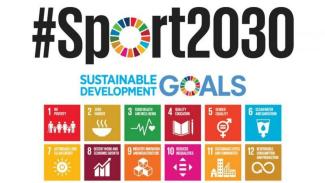Sport-for-development and peace (SDP)
The term sport-for-development and peace (SDP), defined as the intentional use of sport to achieve a range of social goals, is relatively new. It was not until the early 2000s that the term SDP began to be conceptualized, taken up, and integrated into sport programs, policies, and research. While the idea of using sport for developmental purposes is not new per se, as can be heard by the discussion in the below podcast, SDP has become increasingly institutionalized and well recognized within the international development landscape since the beginning of the millenium.
In the above podcast, Simon Darnell, Russell Field, and Bruce Kidd, authors of the book 'The History and Politics of Sport-for-Development: Activists, Ideologues and Reformers', talk with Julia Ferreira Gomes and Natan Levi, hosts of the Sport, Social Justice, and Development podcast. Simon is an Associate Professor of Sport for Development and Peace at the University of Toronto's Faculty of Kinesiology and Physical Education. Russell is an Associate Professor at the University of Manitoba's Faculty of Kinesiology and Recreation Management. Bruce is a Professor Emeritus of Sport and Public Policy at the University of Toronto's Faculty of Kinesiology and Physical Education.

SDP programs can now be seen around the world, from large scale nonprofit and nongovernmental organizations such as Right to Play, to companies funding and sometimes even playing a role in implementing programs, to community-based organizations working to offer youth social and economic opportunities. SDP organizations sometimes operate internationally in multiple locations, others work explicitly with certain communities in the Global North, and still others may focus their development efforts in regions or countries of the Global South. SDP organizations also use a variety of sports and/or physical activity, such as: football (soccer), basketball, lacrosse, skateboarding, surfing, bicycling, and play activities. Some SDP offer programs to massive amounts of youth, others provide activities to small communities, and still others sometimes focus on certain groups and individuals.
Thematic Areas of SDP
Given the scale that SDP now occurs around the world, it remains difficult to identify all the social issues that organizations are seeking to respond to and, via SDP, hopefully resolve. However, there are various 'thematic' areas that SDP organizations and programs focus on, and which researchers and practitioners have explored. Many of these areas relate to the United Nations Sustainable Development Goals (SDGs), and the United Nations have actually outlined the specific ways in which sport might contribute to the SDGs, indicating that SDP holds a place in the broader field of international development. In the following, we briefly identify some of the key areas that SDP actors are targeting and provide links to articles related to each area. There are many more social issues than those listed below that SDP actors focus on in research, policy, and practice (see Svensson & Woods, 2017 for an overview of SDP organizations and different thematic areas).

Understanding SDP Organizations and Management
Another area of SDP research that has occurred and has been beneficial for the growth and operation of the field is in the area of management and organizational studies. While there are various thematic areas above that display the different areas in which researchers, policy makers, and practitioners are interested in understanding how and in what ways sport might contirbute to specific development goals, just as important to consider is the way in which organizations, staff, practitioners, and volunteers design, construct, and implement SDP programs. Various scholars have also discussed particular theoretical frameworks to apply to the study of SDP which may be adaptable for different contexts. In the following section, key areas of literature related to the management and organization of SDP are listed and articles offered for further reading.
CRITiques and challenges of sdp
"We are concerned that sport-based development programs are often not as focused and effective as they could be. Even worse, we believe some of these well-intended initiatives may not be serving the ends toward which they are directed, or are even having counterproductive results." (Hartmann & Kwauk, 2011, p. 286)
Whilst there has been a sensational growth since the early 2000s in SDP policy, research, and practice, there has also been questions, concerns, and critiques raised by various actors involved in the SDP sector. Though sport may definitiely hold possibilities to contribute to some of the international development aims listed above, at the same time, the way in which programs are structured and delivered, as well as the ideologies and frameworks of knowledge that are used to inform SDP programs, must be considered critically. For instance, beyond organizational challenges such as resource scarcity, limited funding, and competition for grants and donations for SDP programs, researchers have highlighted that there remain power imbalances between the global North (whom often provide resources for SDP activities) and the global South (where SDP activities are mostly implemented). These power imbalances may influence the adoption of Western 'development' aims for SDP programs being implemented in the global South, and sometimes these aims shape SDP activities in ways that reproduce power inequalities and emphasize Western ways of knowing such as neoliberalism.
There has also been critiques raised about the role of Western volunteers and interns working in the global South and bringing certain ideologies to SDP activities. Finally, the way in which research is conducted with local communities and groups who are the participants of SDP programs must be considered, particularly as research may be exploitative and lead to limited benefits for those involved in SDP if not co-constructed and implemented in ways that ensure reciprocity. Given these multitude of critiques, anyone interested in becoming involved in the SDP sector should consider the power dynamics and inequalities that are inherently intertwined with the idea and field of SDP.
Other resources
There are many other sites that provide information about the SDP field, jobs, articles, and more. Here is a list of some other resources for SDP:
What is Sport for Development and Peace?
Digital Museum Credits
Lead author: Dr. Mitchell McSweeney, University of Minnesota, mmcsween@unm.edu